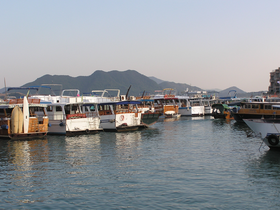
Typhoon shelter
Encyclopedia

Hong Kong
Hong Kong is one of two Special Administrative Regions of the People's Republic of China , the other being Macau. A city-state situated on China's south coast and enclosed by the Pearl River Delta and South China Sea, it is renowned for its expansive skyline and deep natural harbour...
.
Structure
In its usual form, a typhoon shelter is usually in the form of a bay or a cove, with a narrow opening for access, as most of the opening to the seas are blocked by a man-made breakwaterBreakwater (structure)
Breakwaters are structures constructed on coasts as part of coastal defence or to protect an anchorage from the effects of weather and longshore drift.-Purposes of breakwaters:...
.
Usage
A typhoon shelter, as it name suggests, is used by small to medium ships as a shelter against gale force winds and rough seas during a typhoon strike. It is also used to moor yachts-the shelter in Causeway BayCauseway Bay
Causeway Bay is a heavily built-up area of Hong Kong, People's Republic of China, located on the Hong Kong Island, and covering parts of Wan Chai and Eastern districts. The Chinese name is also romanized as Tung Lo Wan as in Tung Lo Wan Road...
in Hong Kong is often used for that purpose-and some typhoon shelters have wharves
Wharf
A wharf or quay is a structure on the shore of a harbor where ships may dock to load and unload cargo or passengers.Such a structure includes one or more berths , and may also include piers, warehouses, or other facilities necessary for handling the ships.A wharf commonly comprises a fixed...
for cargo.
Life in typhoon shelters
Before the 1990s, there was a fairly large population living on boats in typhoon shelters. Many of them were the descendants of fishermen or boat peopleTanka (ethnic group)
The Tankas or Boat people is a special group of people in Southern China that has traditionally lived on junks in coastal parts of Guangdong, Guangxi, Fujian, Hainan, and Zhejiang provinces, as well as Hong Kong and Macau...
. They developed a distinct culture that is different from the mainstream cultures found in Hong Kong. The culture is, by many definitions, a fully developed one, with its own language, wedding rituals and other things such as food, songs and superstitions.
The life and culture of the descendants of these fishermen has often been glamourised, and effectly hid the truth of the extreme poverty that existed among these people. Since they often had to go out to sea to fish, the children of a fisherman's family often did not go to school. This created the need for "floating schools", operated by religious organisations, to educate children living in typhoon shelters. Also, as the catch was variable income was not steady.
Finally, as it is impossible to establish proper plumbing and garbage collection services among these boats, sanitary conditions in typhoon shelters during the time where there were many people living in it were atrocious.
Typhoon shelter crab
Typhoon shelter crab , a dish served in a many of Hong Kong Chinese restaurants, is believed to have originated from the typhoon shelters. It is commonly prepared with crab meat, garlic, scallion, red chili and black beans.Present day
Hong Kong's status as a fishing city continues to decline, the descendants of the fishermen have moved onshore, and the so-called "Typhoon Shelter" culture is rapidly being lost. The function of typhoon shelters remains unchanged, however, and its existence is still vital to Hong Kong, even after all these years.Some restaurants serving typhoon shelter-style cuisine have moved to shops on shore.

